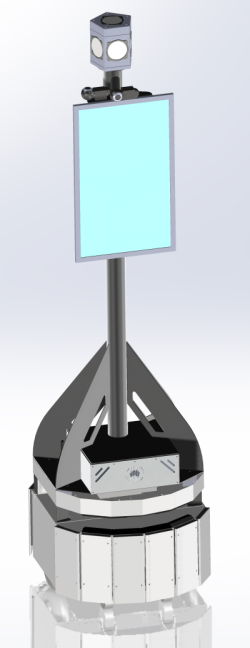This article is more than 1 year old
'Six-eyed' robot to tour National Museum of Australia
Wi-Fi-guided bot will test NBN scenarios, augment reality for virtual visitors
The National Museum of Australia will trial a mobile robot as a way of facilitating more student visitors to the institution. Around 90,000 students visit the museum each year, but Australia has more than four million students across all tiers of education. Most are at least 300 km from the Museum's Canberra home.
The Museum and Australia’s government research house, the CSIRO, received AUD$2.4m of cash for the project, which will commence in October 2012 and is designed to overcome the tyranny of distance while also exploring how technology can make cultural institutions more accessible.
The bot in question, visible in concept design at right,  will boast six Ladybug2 cameras. While each camera captures 30 frames per second, and while they do so at just 1024x768 images the spherical lens employed offers more verisimilitude than a conventional camera. The project will take images from the five Ladybugs mounted horizontally atop the bot’s central stalk and aggregate them into a single image that simulates an in-museum stroll by a real person.
will boast six Ladybug2 cameras. While each camera captures 30 frames per second, and while they do so at just 1024x768 images the spherical lens employed offers more verisimilitude than a conventional camera. The project will take images from the five Ladybugs mounted horizontally atop the bot’s central stalk and aggregate them into a single image that simulates an in-museum stroll by a real person.
Other equipment on the bot will include an 802.11g widget to hook up to the Museum’s newly-installed campus-wide WLAN, plus a small form factor PC to handle general processing chores. A screen on the bot will capture video from virtual visitors, so they can interact with museum guides. 12 volt batteries will help the ‘bot to roll around.
The precise details of just how tours will work and how interactions with guides will take place are being worked out, but both Dave Arnold (the Musuem’s Manager, Education) and Jonathan Roberts (Research Director at CSIRO’s Autonomous Systems Laboratory) are emphatic that the robot won’t replace human guides. Indeed, both believe the bot will work best when accompanied by a human guide, as the presence of a person familiar with exhibits will mean virtual visitors can inquire about what they are seeing as they make their online tours of the facility.
“The idea is that the robot goes along with an educator,” Roberts said. “It is not replacing guides. In fact we should increase the number of guides in the museum. We want to get kids who just look stuff up on the website to visit and talk to the educator live, because we are big fans of storytelling and believe the power of education needs interaction.”
Back end software powering the too: Arnold and Roberts both imagine augmented reality making its way into the system so that remote visitors are offered the chance to click on-screen prompts that reveal more information. That plan reflects the fact that ‘bots have obvious limitations such as being unable to peer at particular details of an object on display.
Roberts said current plans therefore call for programming that ensures bots get the best possible view.
“Exhibits are often behind glass, which is a nightmare for reflections,” he told The Register. “Humans are good at figuring that out, but it is more of a challenge for robots, so we will pre-select positions that minimise and are the ideal location for remote viewing.
The ‘bot itself, and the systems described above, are currently being developed by CSIRO, as is the software that will stream ‘bot-captured images back to visiting students.
Roberts’ plan is for a server to collect all the incoming imagery, so that students don’t have a direct link to the ‘bot but can instead select the output they wish to view. Multiple students could therefore take control of individual cameras and focus on whatever interests them the most, rather than being subjected to a single feed.
That aspect of the project will, Roberts said, help CSIRO, the Museum and the wider community understand how Australia’s National Broadband Network (NBN) can be used for future applications.
“Part of this project will determine what sort of broadband speeds are needed for quality of service,” Roberts said. “Faster connection with lower latency will mean better experience for educators and student, and one of our goals is to figure out the point at which extra speed makes no difference, because now we don’t know. A lot of it is cognitive – is a 0.2 second delay okay? As researchers, we cannot say yet, so we’ll try a lot of different speeds.” ®
